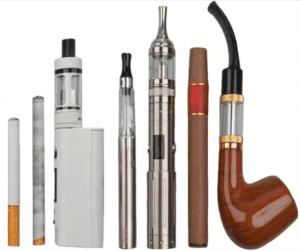[vc_row][vc_column][vc_column_text]
 Media inquiries: Megan Arendt
Media inquiries: Megan Arendt
media@ash.org | (202) 659 – 4310
Electronic cigarettes have hit the American market with force, and their use has increased dramatically in just a few years. The tobacco industry has gotten into the game, bringing big money into e-cigarette marketing. At ASH, we welcome nicotine replacement therapy products that have been proven to help smokers quit, and a number of FDA-approved products are available on the market. While there are certainly some smokers that have moved from combustible cigarettes to e-cigarettes, there are millions of kids who risk becoming life-long nicotine addicts.
 We are deeply concerned by the lack of regulation surrounding e-cigarettes and their marketing. As a science-based advocacy group, we believe product regulation should be based on the magnitude of potential harm. For combustible cigarettes, that means phasing out their sale altogether. For e-cigarettes, we simply do not have all the facts yet. However, we should employ the precautionary approach and err on the side of over-regulation.
We are deeply concerned by the lack of regulation surrounding e-cigarettes and their marketing. As a science-based advocacy group, we believe product regulation should be based on the magnitude of potential harm. For combustible cigarettes, that means phasing out their sale altogether. For e-cigarettes, we simply do not have all the facts yet. However, we should employ the precautionary approach and err on the side of over-regulation.
Here is what we do NOT know
Whether e-cigarettes help smokers quit. There are some anecdotal stories of ex-smokers who could not quit until they tried e-cigarettes, but there is relatively little and sometimes contradicting research yet to corroborate this claim.
The impact on children. According to the CDC, the number of teenagers using e-cigarettes is increasing alarmingly (U.S. Surgeon General’s April 2019 Advisory on E-cigarette Use Among Youth, CDC’s Quick Facts, and FDA’s 2019 National Youth Tobacco Survey).
The contents of the vapor. The marketing is aimed at making consumers think e-cigarettes just emit water vapor, but they do not. There is some strong evidence that the vapor contains toxins and carcinogens, and because there are scores of unregulated manufacturers (CDC), it is impossible to know what exactly is being inhaled by the people who are exposed to vapor from e-cigarette users.
The health impact on users. Without knowing their ingredients, we cannot know the health effects that result from e-cigarette usage or exposure. While e-cigarette companies claim they are safe, they have no scientific evidence to corroborate this claim either.
Here is what we DO know
E-cigarettes are aggressively marketed to children, with flavors like bubble gum and cotton candy. The marketing is disturbingly similar to past cigarette marketing that is now illegal.
E-cigarettes are nicotine delivery devices. Nicotine is highly addictive, according to the National Institute of Drug Abuse (NIDA).
The Food and Drug Administration is researching e-cigarettes in order to determine safe and necessary regulations (like all other products we ingest), but there has been no FDA oversight of e-cigs currently on the market.
Here is ASH’s stance
[ASH’s statement on the 1st long term study on the impact of vaping, published December 16, 2019]
If e-cigarettes are safe, the e-cigarette companies should prove it. At present, they are in the business of selling an addictive drug, and they are targeting children. Simply saying e-cigarettes are “safer” than cigarettes does not say very much; cigarettes are the most dangerous consumer product ever conceived. Almost anything is safer. For now, while the safety of e-cigarettes remains in doubt, they should be treated like cigarettes are now treated. This means:
• No “vaping” in places that ban smoking;
• No advertisements on television, radio, or billboards;
• No marketing to children whatsoever;
• No flavors (including mint or menthol);
• No sales to children, with a ban on internet sales;
• No misleading health claims.
A growing number of states and cities in the U.S. and foreign countries already regulate e-cigarettes, and ASH encourages all jurisdictions to do the same. We, along with many other public health and regulatory organizations, also urge the FDA to move as quickly as possible to regulate e-cigarettes at the national level and to protect the health of everyone. Check out the Public Health Law Center’s interactive map showing E-cigarette regulations in different states.
Additional Information
– How the FDA is regulating e-cigarettes (updated Sept. 10, 2019)
– State and Tribal steps following the 2019 vaping illness outbreak (updated Nov 15, 2019)
– World Health Organization (WHO): 2019 tobacco epidemic report (see Tables 11.2 for adult and 11.4 for youth e-cigarette use).
– Country Laws Regulating E-Cigarettes
– The Tobacco Prevention Toolkit from Stanford:Materials for educators, administrators, parents/guardians, and anyone who works with youth.
– Resources from the CDC and Scholastic to educate youth grades 6-12 on vaping (published Nov. 14, 2019)
– Quit Vaping resources from the Truth Initiative
E-Cigarettes in the News
– Every Thursday, the CDC is updating this link with the latest number of deaths and reported lung injury cases during the US’ outbreak of vaping illnesses and deaths. They will also share what information they’ve found on possible cause(s).
– New CDC report provides first analysis of lung injury deaths associated with use of e-cigarette, or vaping, products (October 28, 2019)
– What are the respiratory effects of e-cigarettes (Clinical Review in the British Medical Journal, September 2019)
– What the FDA is and is not talking about doing now (UCSF, September 13, 2019)
– FDA: Trump Administration Combating Epidemic of Youth E-Cigarette Use with Plan to Clear Market of Unauthorized, Non-Tobacco-Flavored E-Cigarette Products (September 11, 2019)
– FDA investigating reports of 127 seizures after vaping (August 2019)
– Federal Court Sets 10-Month Deadline for E-Cigarette Makers to Apply to FDA to Keep Products on the Market (July 2019)
– WHO says e-cigarettes, ‘smoke-free’ products do not help reduce cancer (July 2019)
– Where does e-cigarette regulation stand today? (May 2019)[/vc_column_text][/vc_column][/vc_row]